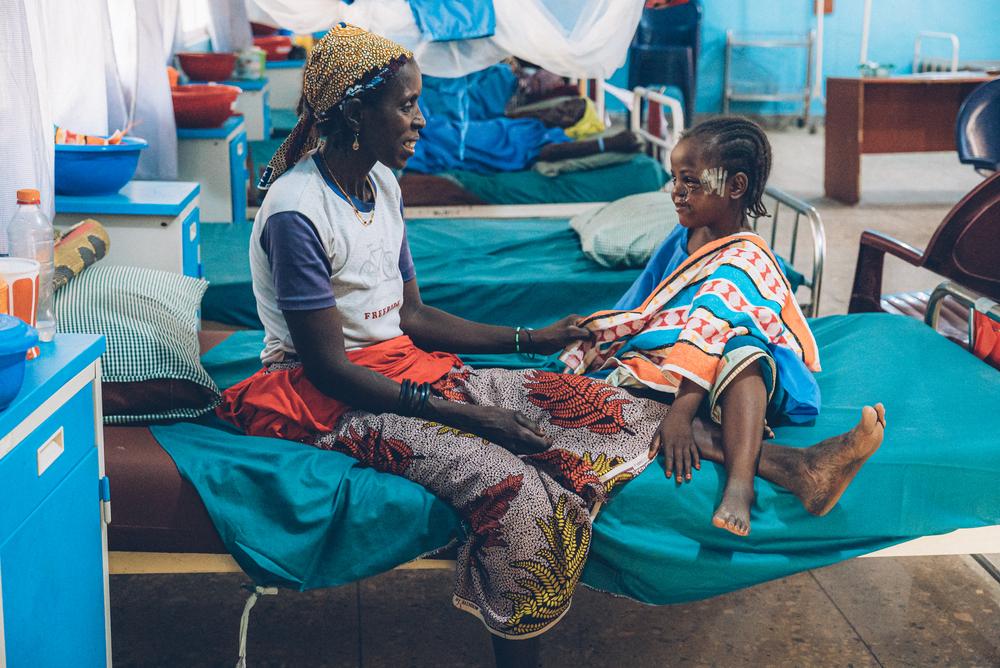
Noma
A neglected disease
Noma is a neglected disease that affects people living in poverty. It’s an infectious but non-contagious bacterial disease that starts as an inflammation of the gums, similar to a small mouth ulcer. The infection destroys the bone and tissue very quickly, affecting the jaw, lips, cheeks, nose or eyes, depending on where the infection started.
It takes just days for noma to leave survivors with severe facial disfigurements that make it hard to eat, speak, see or breathe. On top of that, survivors must deal with the social stigma caused by the horrific damage done to the face.
Noma mostly affects children under seven years old who are living in poverty. Poverty and poor health are the main factors behind the infection that leads to noma. Children with malnutrition, bad oral hygiene and diseases such as measles or malaria are particularly susceptible to noma.
People who survive noma have only one choice if they want a better life: they must undergo extensive reconstructive surgery.
How many people die of Noma
Up to 90 per cent
of people affected by noma die in the first two weeks if they don’t receive treatment with antibiotics in time. That’s why early detection and awareness raising campaigns are so important for a disease that affects an estimated 140,000 children every year. *
*These numbers are an estimate that the World Health Organization (WHO) made in 1994. The fact this data has not been updated in more than 25 years, shows how neglected this disease, and its survivors, are.
Where do you find Noma?
Noma is most prevalent in low-income settings in Africa and Asia. Noma used to occur widely in Europe but disappeared as living conditions and access to healthcare improved.
The disease was first reported by Hippocrates in the the fifth century BC. The first medical description of noma was in 1595, when it was called ‘water cancer’. In Europe, cases were also reported in concentration camps during World War II.
What are the symptoms?
Noma starts with gingivitis, an inflammation and bleeding of the gums. In three or four days, an ulcer appears and the gums and cheek begin to swell. Before a week has passed the disease has eaten away cheek tissue and a hole appears. In the following days, the infection spreads and gangrene covers the affected area. Depending on where the infection has started, it quickly destroys the jaw, lips, cheeks, nose or eyes.
What are the consequences?
Many people who survive noma are at great risk of dying from secondary complications. They experience physical and mental consequences which isolate them from their communities and can cause mental health problems. Many people also have difficulty speaking and eating and face stigma and discrimination in their communities because of their facial disfigurement. Children can experience developmental delays because of their social isolation, or from the impact of childhood diseases linked to noma, such as measles and malaria.
Is Noma preventable and treatable?
Noma is absolutely preventable, but only if there is knowledge about the disease and how to treat it. Good nutrition, oral hygiene and access to healthcare and vaccinations against childhood diseases all help to prevent noma.
Noma is treatable if detected and managed during the first weeks of the disease. With basic oral hygiene, antibiotics and wound dressing a patient can recover from noma within a few weeks. This is helped by managing underlying risk factors, such as malnutrition and other diseases like measles.
With these steps, a patient can recover in 2 weeks.
If it is easily treatable, why do people die from Noma?
People die from this easily preventable and treatable disease because of the lack of knowledge surrounding noma. Early detection is low and once noma attacks, many families don’t have access to or can’t afford the antibiotics to treat it. Most of the people with noma live in poor and isolated areas, where access to health and dental care is almost non-existent.
Little is known about noma. It develops quickly, so the parents of a child with noma usually don't know how to identify the disease. They seek help in their community or from traditional healers, losing precious time and the opportunity to properly treat the infection.

